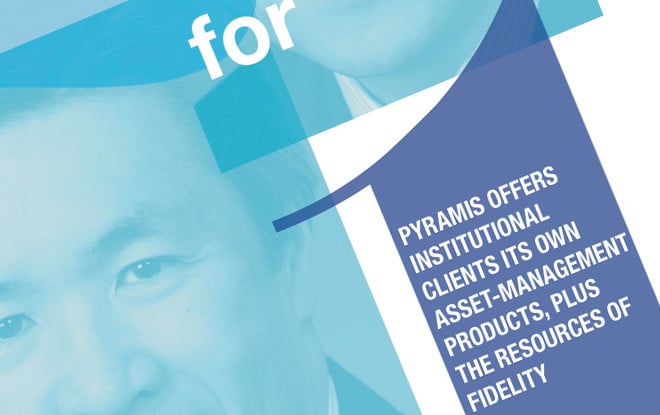Pyramis Global Advisors isn’t your average asset manager.
The eight-year-old firm manages $188 billion — more than the GDP of Middle-East petrostate Qatar — from the fairly obscure New England town of Smithfield, Rhode Island (population 20,000).
That situation in itself is not especially unusual in the decidedly low-profile business of investing money on behalf of giant pensions, endowments, and foundations. What is unique about Pyramis is that its parent company is just an hour and a half away in Boston — and that parent is Fidelity Management and Research, arguably the world’s best-known investment firm.
Pyramis works both angles into its value proposition.
“We feel strongly that the way we can most cleanly add value consistently for our clients is by enabling our portfolio managers to focus on their particular approach to outperforming the benchmark, while using the tools and resources that our organization can bring to bear,” said Young Chin, Pyramis’ chief investment officer.
Pyramis was formed in 2005 to focus on institutional investors, who typically have different wants and needs than the individual investors Fidelity is known for targeting via television commercials featuring green lines and folksy, plain-talking fund manager Peter Lynch.
“We are a manufacturer of products that are specifically tailored to the institutional marketplace,” Chin told Markets Media in a March 14 interview at Fidelity’s Boston headquarters. “We are also a window, or portal, into the broader Fidelity offerings that are relevant for institutional investors, and we distribute all products from within Fidelity.”
“We're also a partner with Fidelity with respect to our investment platform, so we can leverage each other's skill sets, especially with research,” Chin continued. “In many ways on the investment-platform side we try to have the best of both worlds — we have a separate carve-out so we can focus on the products and needs of institutional investors, but we’re also part of a much larger organization that includes the broader research platform across Fidelity.”
AUM Breakdown
Pyramis’ assets under management as of December 31, 2012 included $87.4 billion in international equity, $71 billion in fixed income, $25.5 billion in U.S. equity, and $3.6 billion in alternatives. The high proportion of international equity “speaks to how we are a global organization in our focus, products, and capabilities,” Chin said.
“Our platform, unlike many other platforms, is truly global in nature as opposed to dividing the world between U.S. and non-U.S.,” Chin continued. “We’re a global organization in how we've built our overall capabilities — we have global sector specialists and research teams based in the U.S., Europe and Asia. We continue to promote high fluidity of our investment personnel in terms of traveling overseas and being active outside home-base geographies. Our clientele is quite global, with roughly half from overseas.”
Pyramis’ approach is very much bottom-up, i.e. the investment-selection process starts at the company level. “We don’t have a global macro view that we impose on each of our specific investment strategies,” Chin said. “We do have house views with respect to where economies and markets may be heading and where the headwinds are, and we ask our portfolio managers to incorporate that into their overall strategies, but we don’t necessarily impose that top-down point of view.”
As of year-end 2012, Pyramis’ 635 clients included 300 defined-benefit or pension plans, 109 defined-contribution or 401k plans, 67 endowments and foundations, 35 Taft-Hartley plans, and 124 other entities including sub-advised investors and sovereign wealth funds. The firm’s 920 employees are located in Smithfield plus satellite offices in Boston, London, Hong Kong, Toronto, Montreal, and Tokyo.
Pyramis increased assets under management by about 88% and added 105 net new clients from mid-year 2005, when it had $101 billion and 530 clients. While not a massive gain considering the eight-year timeframe, the expansion — amid turbulent markets — has shown that Pyramis can win business on its own, rather than just via the Fidelity name.
Investment returns provided by Pyramis show benchmark-beating performance, at least before fees. Pyramis’ Select International strategy showed a gross return of 21.6% in 2012, compared with 17.3% for its MSCI EAFE benchmark. Over the seven years ending in 2012, annualized return was 3.33% versus 2.19%.
Pyramis’ Select Global Small-Cap Equity strategy showed a gross return of 23.6% in 2012, compared with 17.5% for its S&P Developing Small-Cap benchmark. Since the Pyramis fund’s 2007 inception, the average annual gain was 3.69%, compared with 0.61% for the benchmark.
According to Pyramis Chief Executive Mike Jones, the firm’s increase in assets under management since launch reflects “solid investment performance across international and global equity as well as fixed-income strategies, in addition to new client commitments in strategies such as global small-cap.”
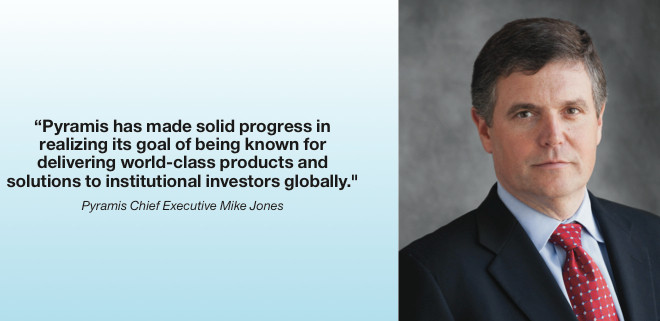
“Pyramis has made solid progress in realizing its goal of being known for delivering world-class products and solutions to institutional investors globally,” Jones wrote in an e-mail to Markets Media. “One of our business goals is to exceed institutional client standards...We’ve risen to that challenge in the U.S. pension marketplace, but now we must meet those standards on a global level.”
Some 2012 Pyramis initiatives Jones cited as meaningful include the launch of a non-directional diversified health-care strategy, and seeding a directional long/short biotechnology fund and low-volatility strategies focused on Canadian and global markets. Also last year, Pyramis expanded its footprint in thought leadership by including Asia in its annual Global Institutional Investor Survey, which Jones said is the largest of its kind in the asset-management industry.
The 2012 survey, whose respondents represented more than $5 trillion in total assets, showed more institutions are seeking to go beyond straight asset management and engage outside asset managers in strategic partnerships in areas such as investment-policy design and asset allocation. One-third of U.S. public plans and 29% of non-U.K. European plans indicated they changed the nature of their relationship with their outside manager in the prior two years, and of those investors, 60% indicated they would move to a partial outsourced-CIO model.
“Clients continue to grapple with low rates and the volatile markets of the past several years,” Jones said. “However, they are approaching these issues in vastly different ways depending on type of plan, region, and plan characteristics” including factors such as funding status, he said.
Researching Stocks
Chin, a 33-year veteran of the asset-management business, joined Pyramis in 2006 from Gartmore Investments, where he was president and chief executive of Gartmore Global Investments, overseeing more than $80 billion. Prior to Gartmore, the Chicago native and son of Chinese immigrants served stints at Brown Brothers Harriman, PNC Financial, and Harris Bank.
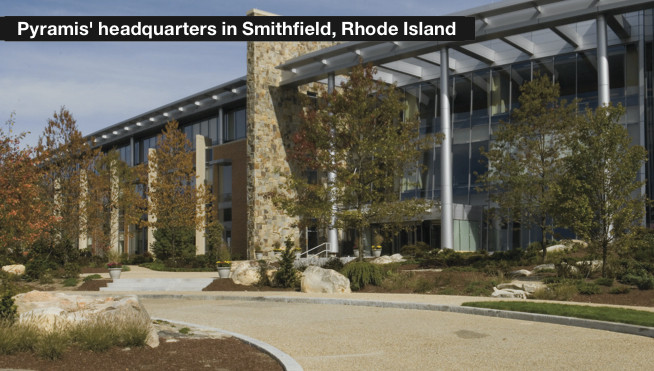
Fidelity, founded in 1946, reported $1.49 trillion in mutual-fund assets under management as of year-end 2012. Fidelity’s 352 research analysts cover more than 7,000 companies worldwide.
“Fidelity and Pyramis are widely known as being deeply entrenched in the areas of fundamental research and stock picking,” Chin said. “We have one of the largest investment-research organizations in the business.”
Pyramis was created “to formalize and improve those (Fidelity) products that already had appeal to institutional investors, but also build and develop products specifically tailored to institutional investors,” Chin said. “We have done that.”
Chin noted that a key benchmark for Pyramis is its standing with institutional-investment consultants, a highly influential constituency that have the ear of pension plans with hundreds of millions or even billions of dollars to allocate. “They are key gatekeepers in judging if our products meet the so-called institutional standard,” Chin said.
Of so-called tier-one consultants, 13 assign ‘buy’ or ‘strong buy’ grades to Pyramis as an asset manager. More narrowly, 17 Pyramis investment strategies are rated buy or strong buy from more than one consulting firm, according to a Pyramis spokesperson. Many of the lights turned green in the back half of Pyramis’ eight years of existence, underscoring that earning a consultant’s seal of approval doesn't happen overnight.
“Consultants can be very particular,” Chin said. “They adhere to the so-called five P's: performance, process, philosophy, price, and people, and they expect you to do that for a sustained period of time.”
“That has its challenges, particularly for an organization that has been more individual-investor, retail mutual-fund focused with products that have more latitude in terms of where they can go and what they can do to add value,” Chin continued. “Institutional products tend to be very specific and customized. You have to stay within your bounds in terms of where you look for opportunities and how you add value.”
“We’ve been working at this for a long time,” Chin said. “We have had to prove ourselves, demonstrate we can meet the grade, and do it consistently over time.”
Within Pyramis, the portfolio manager is the “single point of accountability” for stock selection, Chin said. “We want them to focus on individual stocks, but at the same time they're not stock jockeys, they're portfolio managers.”
Pyramis provides support for how it all ties together in the form of a separate investment-risk team that helps portfolio managers understand risk and efficient portfolio construction, and also helps managers run simulations and tests to determine if a portfolio needs repositioned.
Said Chin, “this really gets to the heart of encouraging our portfolio managers to leverage what I think is our core strength — understanding underlying companies and looking for company-specific opportunities that will result in upward stock-price movement.”
Citing firm policy, Chin declined to discuss specific holdings.
Pyramis’ $71 billion in fixed-income assets under management is sourced from Fidelity's bond group based in Merrimack, New Hampshire. Alternative investments weighs comparatively light at $3.6 billion, or less than 2% of Pyramis’ total asset pie, but Chin noted the segment is one to watch.
Alts Focus
“We're putting a lot of emphasis and focus” on alternative products, he said. It “is a key area for where institutional investors will be allocating more assets.”
Indeed, the trend is already underway. Vexed by persistently low bond yields and an restrained outlook for stocks, pension investment officers have been funneling more money into hedge funds, private equity, and real estate. Public plans with more than $1 billion under management had a median alternative allocation of 15% as of June 2012, the most ever and up from 9.2% a year earlier, according to Wilshire Associates.
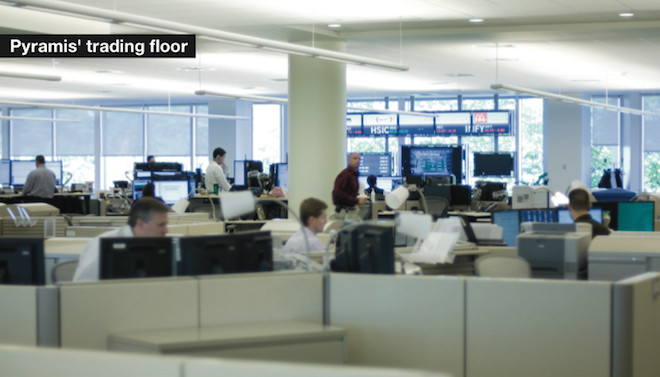
Rather than the money all going to hedge funds and private-equity firms, some pensions that invest money in-house as well as some traditional asset managers are essentially adopting a DIY strategy and competing for a cut, blurring the line between traditional and alternative investment managers.
"Investors are looking past definitions and style boxes and thinking more holistically about exposures and how to access those exposures," said Erik Knutsen, chief investment officer of institutional-investment consultant NEPC.
In its alternatives business, Pyramis is “building capabilities that utilize that same research foundation” developed at Fidelity, Chin said. “This includes products that are absolute-return oriented in terms of equity long-short, or market-neutral products. As investors look at directional markets being quite volatile these days, a blend of both directional market exposure and non-market directional exposure will grow in importance.”
In Chin’s view, alternative investments can help manage volatility and enhance portfolio diversification, while “helping address specific return objectives in different timeframes than traditional asset classes using a long-term expected return approach.”
With alternatives as with equities, Pyramis portfolio managers assess investment opportunities starting from the bottom and working their way up. That’s not to say the firm doesn’t synchronize with its own broader view.
“Global and macro issues do influence where we look for opportunities and how we feel about equity opportunities on a regional basis,” Chin explained. “The global financial crisis taught us that markets are interconnected, so any localized crisis becomes almost instantaneously a global one. So what’s happening on the global macroeconomic front influences where and when we looking for opportunities.”
For example, Chin said Pyramis had taken a step back from investing in Europe given the economic and political turmoil on that continent, but opportunities started to emerge last year amid a potential market bottom. “Our interest in Europe is much more positive today than it was a few years ago,” Chin said.
Pyramis portfolio managers sometimes use derivatives to manage risk. “We have a dedicated investment risk and derivatives team that helps our portfolio managers use derivatives to help hedge exposures,” Chin said. “Risk-aware investing has been an important cornerstone for us ever since Pyramis was formed — my first hire when I joined the organization was a head of investment risk.”
By and large, end-user participants in public pension plans would choose to err on the side of conservatism rather than risk taking, and this extends to the pension-plan investment officers who work for the end users. Given that aversion to taking chances, substandard risk-management processes and systems are not an option for the firms that manage pension money.
Risk-Aware Culture
“What is critical to successfully building products that appeal to institutional investors...is to be risk-aware in how you’re putting together portfolios,” Chin said. “You need a clear understanding of where you’re taking risks, where you see opportunities for risk-taking, and what are you doing to control unintended risks.”
“Our risk team goes beyond reporting on risk,” Chin added. “They work closely with our portfolio managers and me to help oversee risk, and they also perform a ‘player-coach’ function in helping our portfolio managers understand the opportunities in investment risk management, and how to to deliver more consistent returns.”
"We have a separate carve-out so we can focus on the products and needs of institutional investors, but we’re also part of a much larger organization."
Pyramis deploys a proprietary risk platform that enables portfolio managers to view the risk of underlying positions and portfolios, real-time via individual work stations. In addition to PM-level monitoring, Pyramis’ risk-oversight team and Chin can see risk levels across the firm’s platform. “All of us are very well-versed in risk and risk modeling,” Chin said. “it’s not simply a tool to help 'check the box' in terms of what investors expect of us, it’s also a component of how we manage portfolios and part of our day-to-day vernacular.”
Pyramis has its own trading desk, which Chin said “enables us to develop our own trading policies consistent with what institutional investors expect, which can be different from policies and procedures for mutual funds and retail investors.”
The 13-person trading team is part of an open-architecture seating arrangement at the Smithfield headquarters, sitting alongside colleagues from Pyramis’ portfolio management, research, compliance and risk groups.
Holding periods for Pyramis’ equity investments average 18 to 24 months. “We tend not to engage in shorter-term trades — we’re bottom-up stock pickers, we're not day traders,” Chin said. “So we’d perhaps be on the lower side (of turnover) relative to other managers. Even our absolute-return products, where the consistency of performance might be measured in months as opposed to quarters or years, tend to have reasonably low turnover.”
Regarding technology systems, Pyramis buys and customizes some products, and the firm also builds its own in some instances.
“There are advantages for an organization like ours that can buy some off-the-shelf products, customize and take advantage of economies of scale for our required technologies and systems,” Chin said. “That said, with many of our unique and proprietary products, it’s important to be able to build capabilities.
Pyramis is especially likely to build its own systems for risk monitoring on the investment and portfolio levels. “This enables us to customize it specifically to what we're trying to go after, and look at it in terms of how we work with our portfolio managers and oversee portfolio management and portfolio risk,” Chin said. “It also allows us to ‘plug and play’ within our platform, so we can incorporate other risk systems and models into a single common platform.”
Chin expressed concern about market structure, mostly regarding how the prevalence in high-speed trading in today’s markets can dent the returns of the institutions that invest on behalf of long-term investors such as people planning for retirement.
The shortest-term, highest-speed trading is “concerning on a couple different fronts,” Chin said. “These algorithmic, high-frequency traders are trading with greater frequency and looking for smaller stock price movements, competing with each other to a greater degree, and getting to a point where not only are they trying to squeeze out every piece of information that might not be reflected in a stock's price, but they're also trying to anticipate what long-term investors might be moving in and out of.”
“High-frequency trades that try to anticipate what longer-term investors do amplify our trades, adding to volatility,” Chin continued. “To the extent that they are successful in anticipating our moves into and out of markets, they can glean some alpha-generating opportunities that are based on our fundamental insights. So it’s disturbing to see the influence and growth of these types of trading activities in that they come at the expense of long-term investors such as people saving for retirement, who aren’t getting the full value of the insights on the underlying names.”
Studies are mixed regarding high-frequency trading’s impact on institutional investors. Some research has indicated that high-frequency traders add liquidity to markets, narrowing spreads and therefore reducing institutional trading costs. However, according to an industry report published last year, high-frequency traders cost long-term investors as much as $2.5 billion per year because rapid-fire activity in some heavily traded large-cap stocks makes them more expensive to buy.
The U.S. Securities and Exchange Commission and other regulatory bodies have said they are studying high-frequency trading, but action isn’t expected for some time, if ever. Regulators “are making some determinations as to whether (high-speed traders) need to be further regulated or controlled,” Chin said. “I don’t think it helps anybody other than these trading operations."
For Pyramis, Chin said it’s “an area of concern and focus in terms of trying to understand the nature of the trading activities, how they impact long-term investors, and how we react.”
Closer Ties
With regard to the future of institutional asset management, Chin said one discernible trend that will continue is a closer collaboration between institutions such as pensions and the firms that manage their assets.
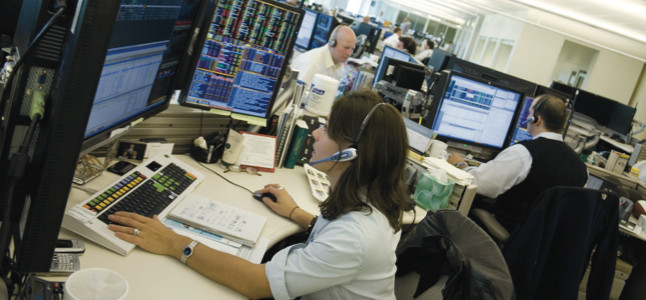
“We’re seeing a transition from building superior products to being more solutions-oriented,” he said. “Many investors come to asset managers like ourselves that have breadth of products and services, not looking necessarily for ‘best-of-breed’ for a specific capability, but looking for solutions to specific investment problems,” such as a gap in a pension plan’s funding, excessive volatility of liabilities, or a lack of consistency in investment returns.
Knutsen of NEPC noted a trend toward being solutions-oriented and customizing products in the institutional asset-management space, “but I wouldn't say it's a tidal wave."
For Pyramis, “the challenge is how do we structure and assemble our products and capabilities in a way that's more tailored to a specific requirement investors have, as opposed to offering just a ‘best-of-breed’ product,” Chin said. “We're spending more time building investment-solutions teams to work more closely with institutional investors, and identify what the opportunities are to address specific investment issues.”











